
Frontline Digital Transformation
20 min read
Connected Workforce | What Is It & How Does It Benefit Companies?

One of the best ways businesses can get ahead and remain competitive is to embrace the available tools. And right now, that means implementing a connected workforce.
Table of Contents
1. Critical Components of a Connected Workforce
2. The Five Pillars of a Connected Workforce
3. Benefits of a Connected Workforce for Companies
4. Challenges In Implementing a Connected Workforce
5. Best Practices for Building a Connected Workforce
6. Examples of Leveraging a Connected Workforce
7. How the Manufacturing Industry Benefits from Connected Workforce
8. Benefits of a Connected Workforce for Manufacturers
The future of work is digital, and a connected workforce benefits every organization. A connected workforce is a network of tools and systems that allow workers to work from anywhere and from any device.
There’s been a lot of talk post-Covid about the effect of the health crisis on the labor force and industry and for good reason.
The pandemic changed the way we work and the way we communicate with each other. And the results are apparent, with 74% of U.S. companies either currently using or planning to implement a hybrid work model – 27% more than before the pandemic hit.
Giving workers the ability to communicate, stay on task, and connect while out of the office is a critical component to the success of this hybrid model. That’s where a digitally connected workforce can make a difference.
Want proof? Gallup states that highly engaged teams show a 21% greater profitability, a 41% reduction in absenteeism, and 59% less turnover. Another report by The Engagement Institute found that disengaged employees cost U.S. companies as much as $550 billion a year.
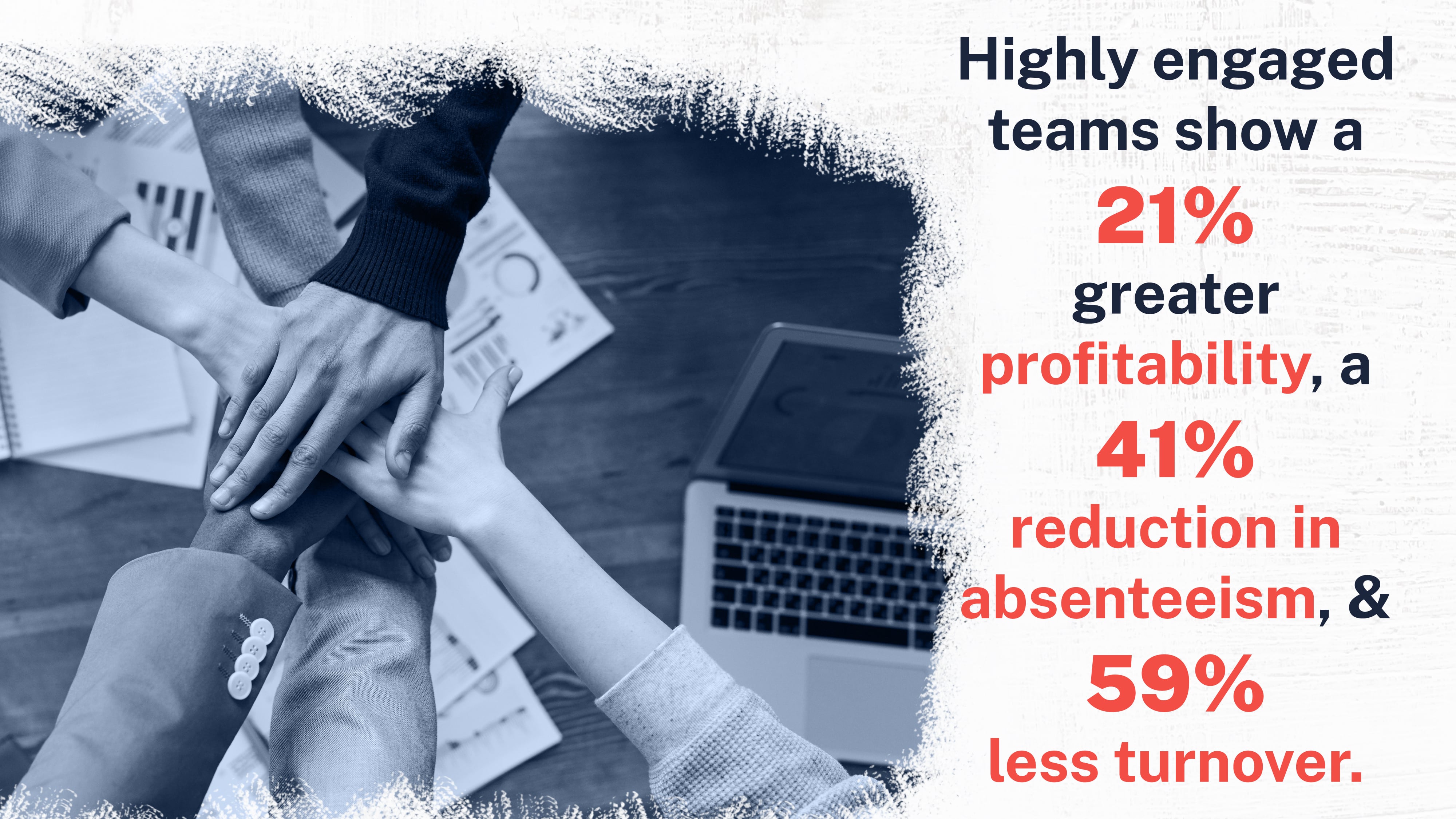
This article discusses how manufacturing companies can successfully benefit from having a connected workforce and covers the best practices to achieve it.
Critical Components of a Connected Workforce
Many of today’s employees want a remote work option. But companies implementing a connected workforce system must do so carefully. That’s because a culture of collaboration can help businesses drive innovation and creativity – two things that add to the profitability of a business.
On the other side of the coin, a poorly utilized hybrid work model can have the opposite effect.
Studies show that two-thirds of remote workers feel disengaged and isolated from their coworkers and company, which increases their likelihood of jumping ship. So, it’s a balancing act between allowing the flexibility of remote work while still encouraging connected workers.
So, how exactly do organizations implement a successfully connected workforce?
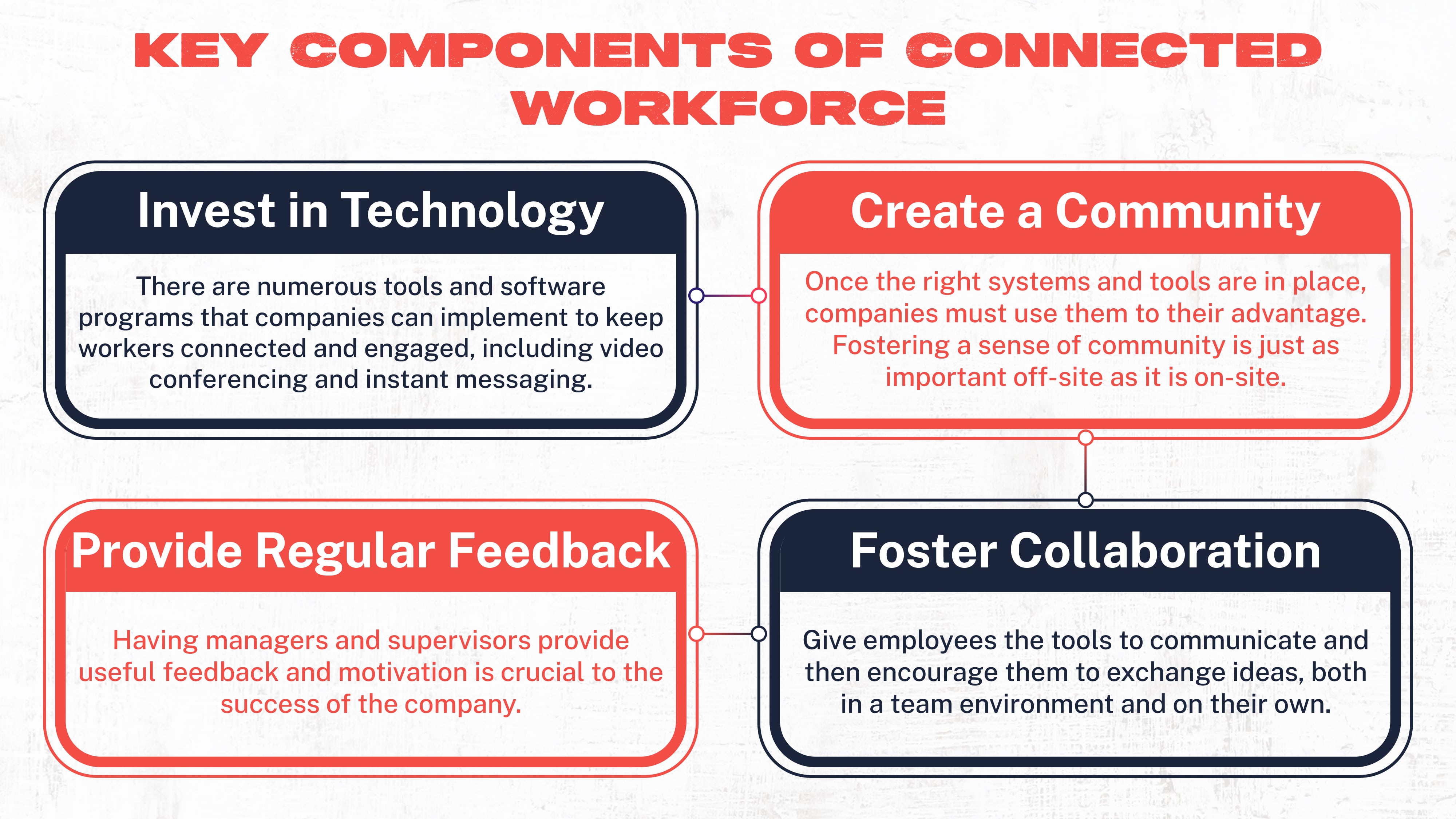
Here are some essential components required to get it right.
Invest in Technology
At the heart of a connected workforce is technology. Companies can implement numerous tools and software programs to keep workers connected and engaged, including video conferencing and instant messaging. Many of these tools work together, making it easy for companies to build a system that meets their needs.
Create a Community
Once suitable systems and tools are in place, companies must use them to their advantage. Fostering a sense of community is just as important off-site as on-site.
Organizations should seek ways for employees to engage with each other for work and community-building. For instance, companies can provide a way for employees to chat with each other in real-time for work-related issues and a separate thread for non-work activities.
Provide Regular Feedback
One of the main concerns for many organizations that want to go remote is more oversight. Having managers and supervisors separated from employees can create an environment where coaching and feedback are less often and less personal.
But managers who embrace technology and use the proper methods can still provide helpful feedback and motivation, and they need to if they want to keep workers engaged.
Foster Collaboration
Give employees the tools to communicate and then encourage them to exchange ideas in a team environment and on their own. Allow employees the time and space to work together toward a common goal.
Dozuki – Collaboration for Manufacturing Companies
Dozuki provides tools that manufacturing companies can use to build a connected workforce. Using Dozuki, workers can access standardized work instructions from anywhere. Organizations can implement training and upskilling remotely. And employees can access digital content libraries to facilitate self-driven learning.
Workers who use Dozuki have access to a collaborative and intuitive dashboard that they can access from any device. And because Dozuki provides so many integrations, organizations can build a system that works for them.
The Five Pillars of a Connected Workforce
An organization's culture significantly affects the happiness, productivity, and satisfaction of its workforce. Building this kind of culture while workers are separated from each other can be challenging, but it can be done.
The Deloitte 2020 Global Human Capital Trends survey found that "belonging" is one of the most critical components of workforce culture, with 79% of organizations putting it at the top of their list in terms of importance.
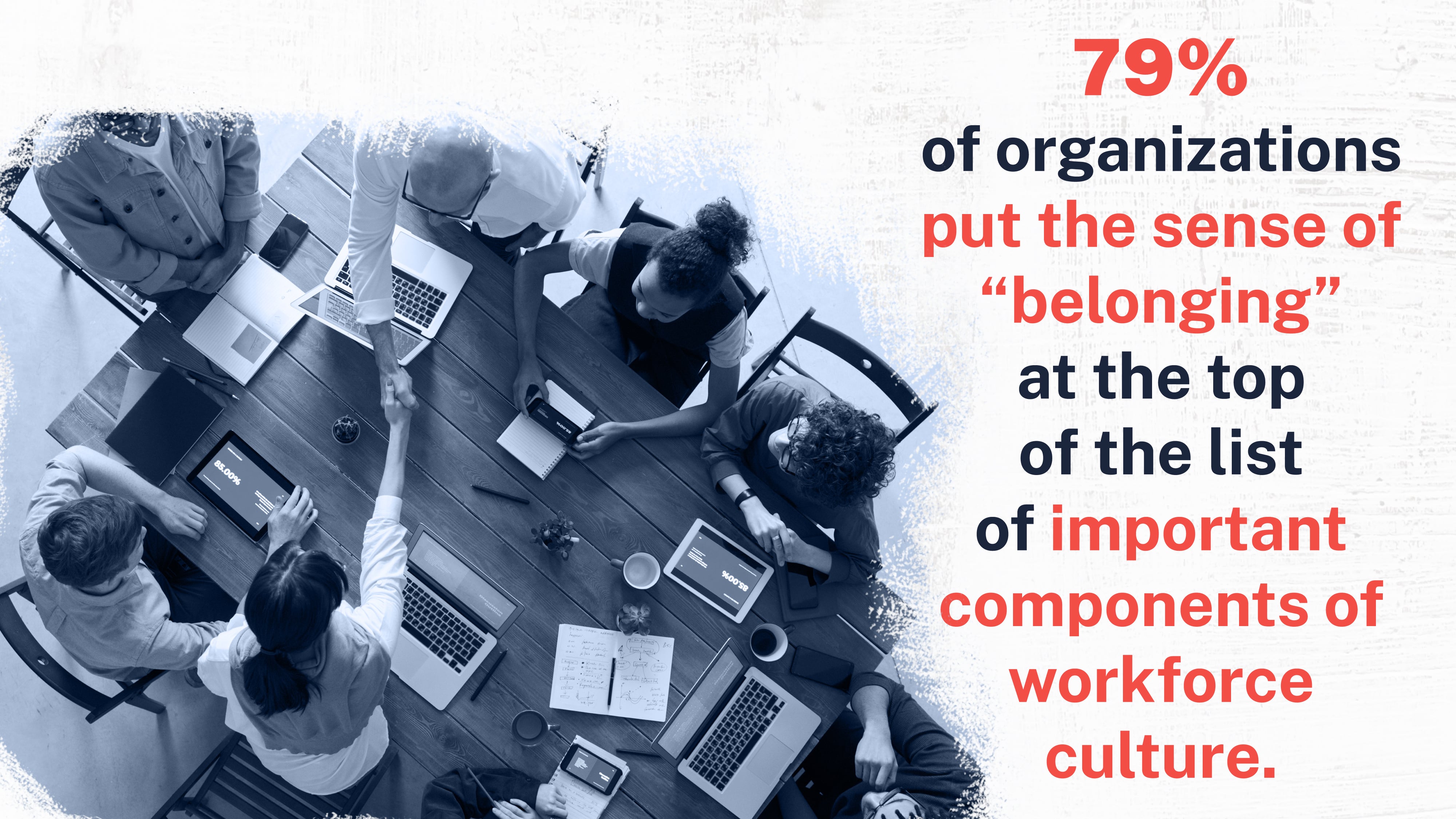
The five pillars of belonging are useful for organizations seeking to build an effectively connected workforce.
Researchers from the Achievers Workforce found that companies who foster this type of culture see 3x more significant returns on business outcomes, such as engagement and productivity. The five pillars of belonging are:
- Purpose – Employees need to feel like they’re a part of something bigger than themselves. This motivates employees to work together toward a common goal.
- Community – Employees need to feel like they’re part of a community that supports and cares about them. Providing this type of environment creates positivity.
- Competence – Employees need to feel like they can be competent in their job roles. And they need to feel like their employer is taking the necessary steps to provide them with that competency.
- Contribution – Employees need to feel like they’re contributing to the organization. This pillar ties back to having a purpose because they also need to feel they’re contributing to the world and society.
- Fairness – Employees need to feel as if they’re treated fairly. They also need to feel like their voice is being heard and their needs are being met.
The Benefits of Belonging
Statistics show that companies lose an average of 18% of their workforce annually. And yet, highly engaged employees are 87% less likely to seek employment elsewhere.
Organizations that put time and effort into building a culture of belonging are likelier to have a sustainable, engaged, and profitable workforce. That means employees will want to be a part of the organization and stick around longer.
Benefits of a Connected Workforce for Companies
A connected workforce provides a lengthy list of benefits for everyone within an organization. And it’s important to note that these benefits extend to on-site and off-site workers.
Increased Collaboration
Most organizations already know the benefit of collaboration within their teams. And part of what makes companies apprehensive about going remote is the fear of losing that collaborative environment. A connected workforce allows employees to work together, collaborate, and strategize - even from separate locations.
According to McKinsey, improved collaboration and communication through social technologies can raise the productivity of employee interactions by 20%-25%.
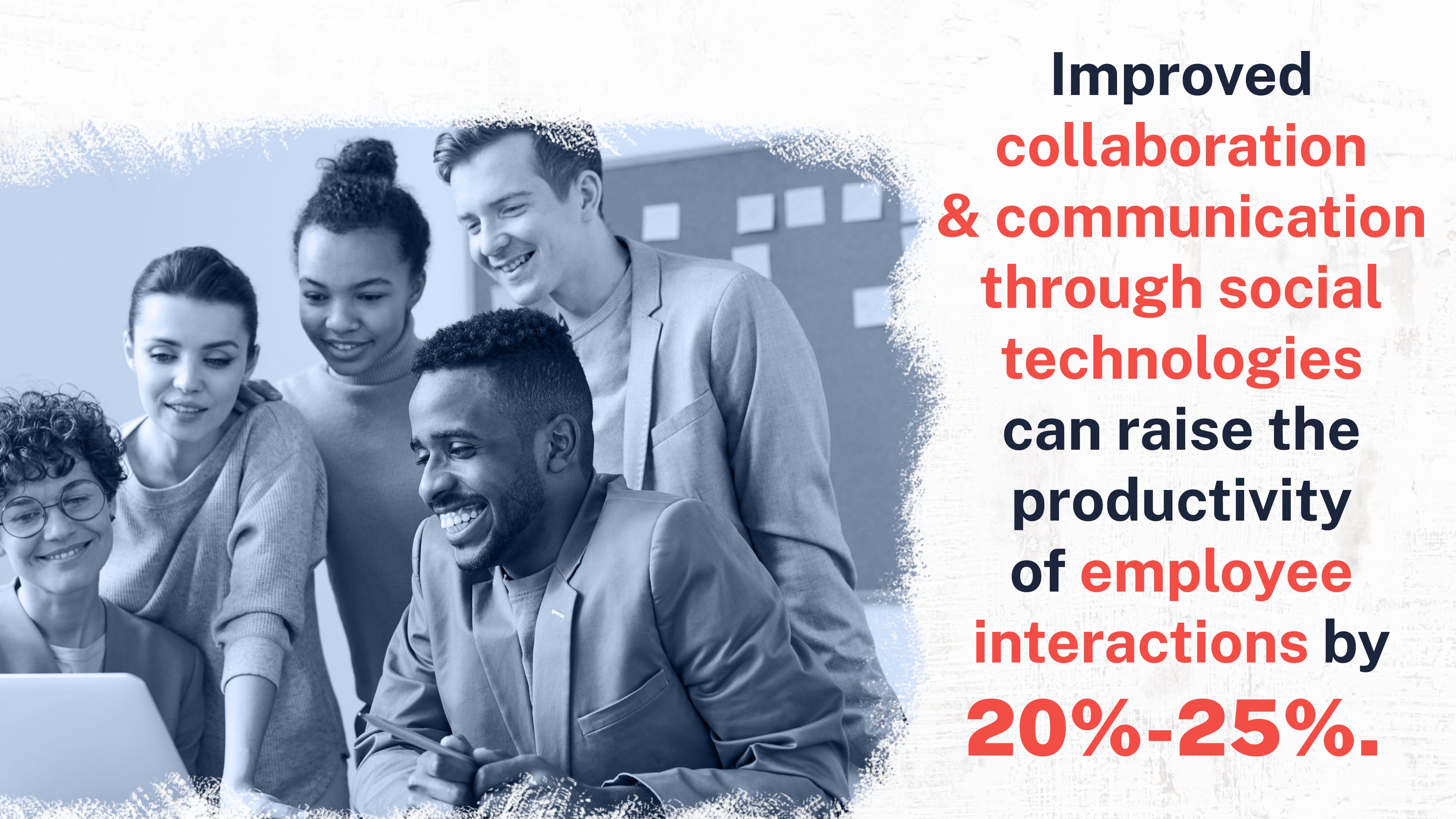
Increased Productivity
Workers empowered with the right tools and systems will inevitably be better organized and more productive. And connected workers are more engaged with their job roles and coworkers, which automatically lends to greater productivity.
Improved Efficiency
Automation and connectivity go hand in hand. Implementing the right tools helps workers automate otherwise time-consuming and repetitive tasks, making them more efficient.
Increased Profitability
Increased collaboration, productivity, and efficiency have a cumulative effect on an organization’s profitability. When workers are operating at peak performance, it helps organizations remain competitive, satisfy customers, and build a positive reputation.
Challenges In Implementing a Connected Workforce
A connected workforce seeks to provide an environment where workers feel like they belong to a community and empowers those workers to connect in real-time. One of the biggest challenges for many organizations is learning how to build a culture of inclusivity.
The nature of remote work means that employees can collaborate from anywhere, and the workforce's diversity is more significant than ever.
This provides some unique challenges and opportunities for organizations.
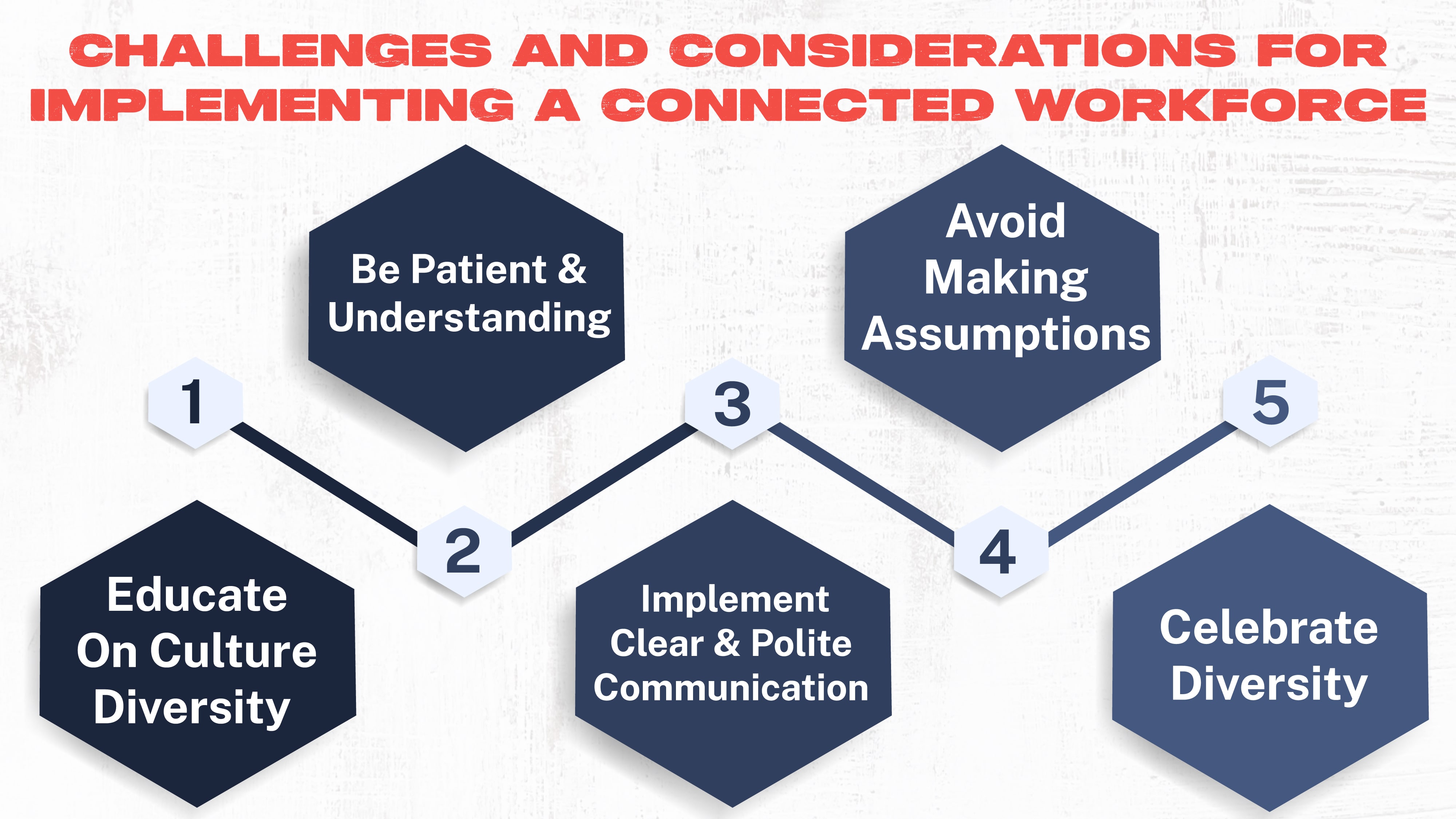
Here are some ways to overcome cultural barriers in the workplace.
1) Educate On Culture Diversity
Employees and managers alike can benefit from knowledge about diverse cultures. Make it a priority to educate employees about their differences and how that uniqueness can work to their advantage.
2) Be Patient and Understanding
Everyone within an organization should show patience and understanding of cultural differences, including accommodations for beliefs or customs.
3) Implement Clear and Polite Communication
Be open and polite in communication, but be sure to communicate clearly and precisely with employees regarding expectations. Outline what is acceptable and what is not so there will be no misunderstanding regarding accepting cultural differences.
4) Avoid Making Assumptions
You've heard what they say about assuming, so don’t do it. The best way to learn how to accommodate cultural differences is to ask.
5) Celebrate Diversity
Try to celebrate diversity in the workplace, even when employees work from separate locations. Foster inclusivity and always understanding.
Employers must take the lead to build a successful connected workforce. Here are some tips to follow to help keep remote workers engaged.
Set Clear Expectations – Ensure employees understand what is expected of them, including work hours, deliverables, and communication. Set expectations and stick to them.
Provide Regular Feedback – Let employees know that their work is valued and that they are contributing to the company.
Invest in Technology – Make suitable investments to build a connected workforce system that meets the organization's and its employees' needs.
Create a Sense of Community – Be wary of the isolation and disconnection that remote workers can experience. Create opportunities for workers to connect and feel like they’re part of a team.
Be Flexible – Remote employees may have unique needs and availabilities and require flexibility in scheduling. Take advantage of the flexibility in a remote work structure.
Best Practices for Building a Connected Workforce
Building a connected workforce requires a few things: using the right technology, training employees to use that technology, and actively working to foster community and communication.
Organizations can use some best practices to encourage and empower connected workers.
Invest in the Right Technology
A connected workforce is most effective when employees access the right tools and systems. There are numerous ways that workers can connect using technology, including these examples:
- Video conferencing has become one of the most popular ways to unite remote workers, allowing a visual connection and team collaboration from anywhere.
- Collaboration hubs and instant messaging allow workers to reach out in real-time.
- Project management tools can help workers stay on task and work together toward a common goal from anywhere.
- Tools like Google Docs allow workers to share and edit files together.
Create a Culture of Collaboration
Siloed information is detrimental to an organization, and a remote work structure can sometimes allow this type of barrier to get in the way of success.
Employers need to foster collaboration and teamwork, especially when employees work from separate locations. Problem-solving, innovation, creativity, and engagement all flourish when collaboration is encouraged.
Provide Training
Every system works effectively with training. Make sure that employees are supported when moving to a connected work system. Providing the necessary training will make employees more confident and better able to collaborate using digital tools.
Examples of Leveraging a Connected Workforce
Ready to see the benefits of a connected workforce in action? Here are two real-world examples of organizations using digital connectivity to their advantage and reaping the rewards.
The Department of Economic Security
DES, or the Department of Economic Security, took drastic measures when Covid hit, transitioning 50% of its workforce to a small structure.
By the spring of 2021, more than 75% of the organization's employees were working remotely, either full-time or in a hybrid capacity. The result was a 25% reduction in turnover and a 3% reduction in absenteeism over the next year.
PricewaterhouseCoopers
PwC, or PricewaterhouseCoopers, uses a mixed remote and hybrid work structure. Employees are either fully remote or split between in-office and remote work.
This international company faced unique challenges when going remote and made efforts to ensure workers stayed connected and engaged, focusing on improving employee retention.
By investing in employee connectivity events, both virtual and in-person, PwC was able to boost employee morale and encourage a community culture. They also implemented inclusion networks, allowing employees to mentor or be mentored by fellow employees.
This helped employees feel more comfortable and confident, engaging and empowering workers to succeed. The result was a better-connected workforce, a company that workers want to be involved with, and increased revenue.
How the Manufacturing Industry Benefits from Connected Workforce
Manufacturing companies rely on an in-person workforce for production.
Specific job roles within the manufacturing industry are simply not suited to remote work, and other functions are. But that doesn’t mean that manufacturing companies don’t need to invest in a connected workforce to remain competitive.
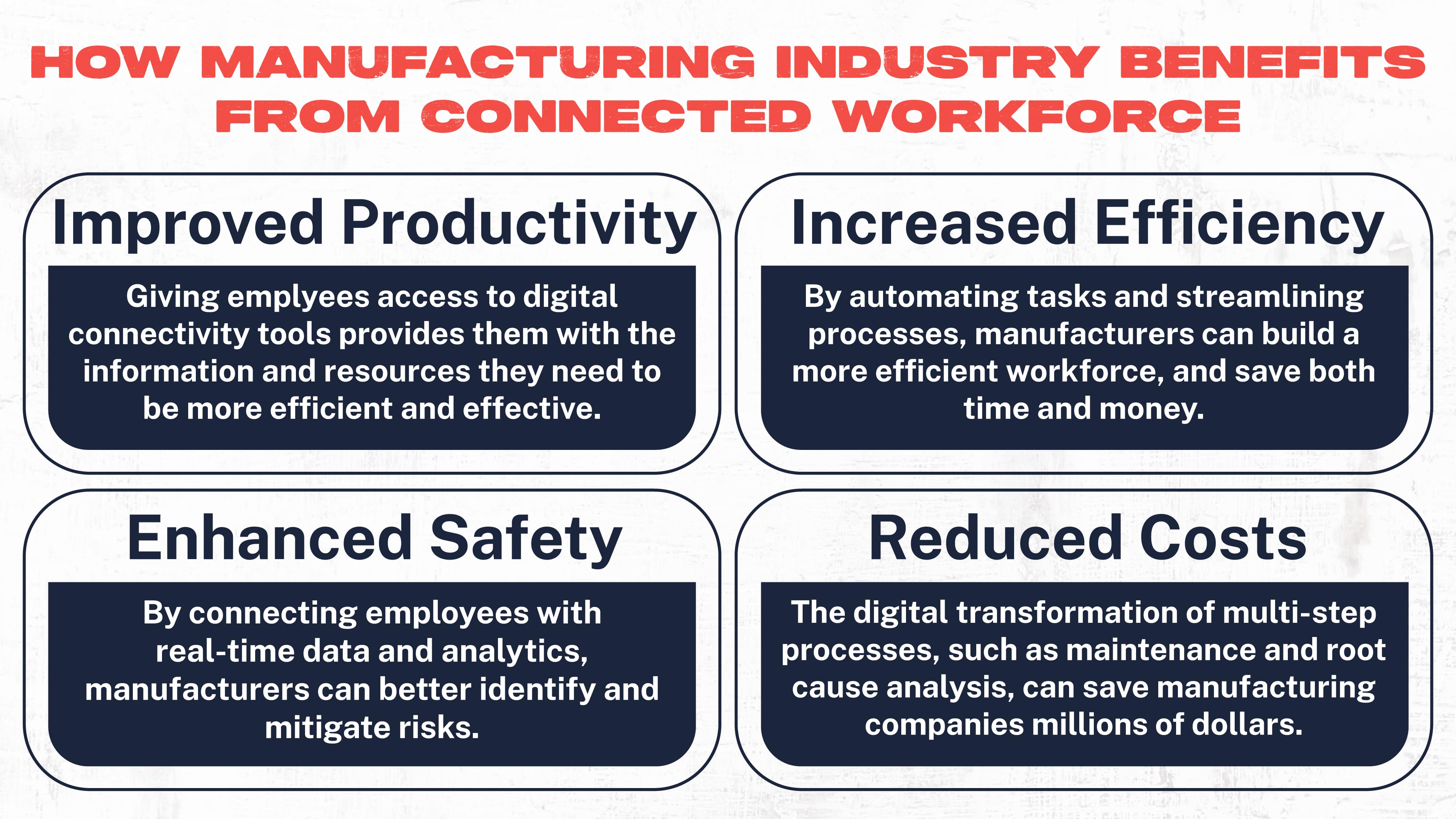
Here’s why:
Improved Productivity
Employees working on the plant floor are often far away from each other. Giving them access to digital connectivity tools provides them with the information and resources they need to be more efficient and effective.
Increased Efficiency
A connected workforce is a streamlined workforce. Manufacturers can build a more efficient workforce by automating tasks, streamlining processes, and saving time and money.
Enhanced Safety
Manufacturers can better identify and mitigate risks by connecting employees with real-time data and analytics. This helps provide employees with the necessary information to keep them safe on the plant floor.
Reduced Costs
According to McKinsey, the digital transformation of multi-step processes, such as maintenance and root cause analysis, can save manufacturing companies millions of dollars. Increased visibility and access to real-time analytics also reduce errors and defects.
Benefits of Connected Workforce for Manufacturers
A digitally connected workforce provides numerous benefits for organizations. Whether workers are on-site or working remotely, connectivity, communication, and collaboration only provide positive outcomes.
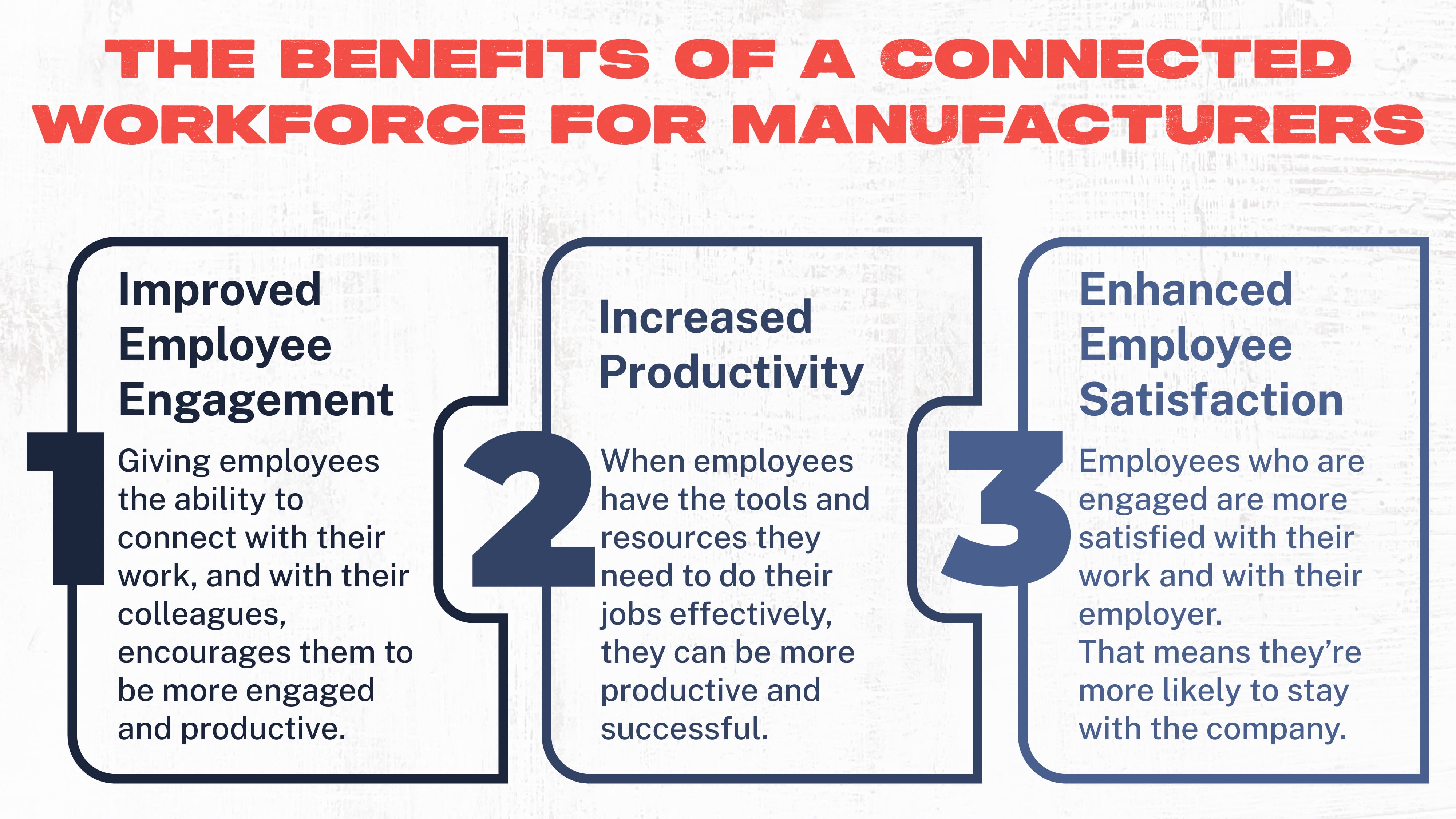
Here are a few of the most significant benefits manufacturing companies can gain by building a connected workforce:
Improved Employee Engagement
Giving employees the ability to connect with their work and colleagues encourages them to be more engaged and productive.
Increased Productivity
Employees can be more productive and successful when they have the tools and resources to do their jobs effectively.
Enhanced Employee Satisfaction
Engaged employees are more satisfied with their work and with their employers. That means they’re more likely to stay with the company.
Final Thoughts
A connected workforce has become somewhat of a necessity for organizations of all types, whether they use a remote or hybrid format, or not. When workers engage with each other, their managers, and their organization, they are more productive, successful, and happier.
Digital connectivity tools can be adapted to the needs of the workers and the business, which makes them incredibly flexible. They can help companies to improve productivity and become more profitable. And they empower workers to build a sustainable work-life balance. They foster cooperation and collaboration. In turn, tools like this can help organizations boost employee retention.
Overall, a connected workforce benefits everyone in an organization. It fosters collaboration and engagement, increases efficiency and productivity, and lowers costs for the company.
Topic(s):
Frontline Digital Transformation
Dozuki: The Leading Connected Worker Platform
Learn why over 500 manufacturing companies have partnered with Dozuki to implement their connected workforce initiatives and drive frontline digital transformation.
Related Posts
View All Posts
Continuous Improvement
The Most Common Manufacturing KPIs and Metrics to Track & Why | 2023
19 min read
Manufacturing is a highly competitive industry, and the road to success has been uphill for many businesses over the last several years. Table of Contents Criteria for...
Continue Reading
Frontline Digital Transformation
The Most Common 8 Wastes of Lean Manufacturing & How to Manage Resources
23 min read
Manufacturing is all about making the highest quality products at the lowest cost. Reaching that goal means searching for and eliminating causes of wasted time, wasted...
Continue Reading
Frontline Digital Transformation
A Comprehensive Guide to Predictive Maintenance in Manufacturing | 2023
18 min read
Effective maintenance requires a well-rounded approach. Manufacturing companies use planned, reactive, and proactive systems to prevent breakdowns and address problems as...
Continue Reading


